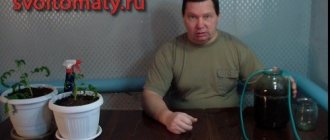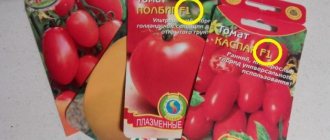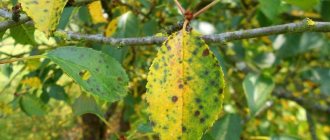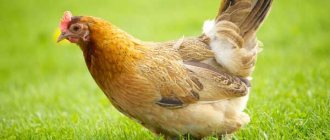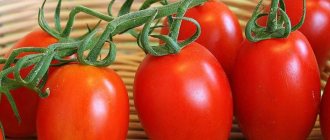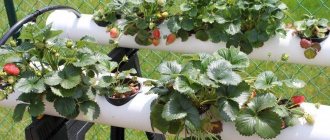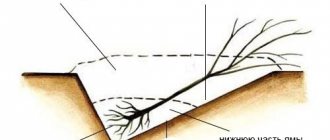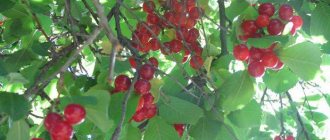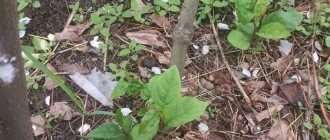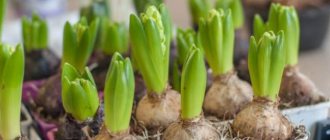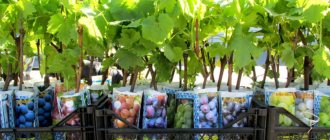How does pollination occur?
The process of pollination involves the arrival of ripe pollen on the stigma of a flower. The pollen grain then germinates in the pistil column, penetrating the ovary, which contains an unfertilized ovule, and thereby fertilization occurs, which subsequently leads to the appearance of ovaries. The transfer of pollen onto the stigma from the pistils of a flower is pollination.
Typically, pollination is carried out by bees or other insects and the wind. There are situations when pollination has to be done manually. For example, if the cherries bloom too early, when there are still not enough insects, or the tree grows in a greenhouse, where access for pollinating insects is completely limited. First, check the readiness of the pollen for fertilization by running your finger over the anther and seeing if yellow lumps remain. After this, the optimal time is selected - this is the middle of the day, after several days of settled warm and dry weather. And daily until the end of flowering, it is advisable to carry out manual pollination using a brush or cotton swab.
Not all cherries are capable of self-pollination; to ensure cross-pollination, they must be planted with other varieties capable of self-fertilization with their own pollen. Different varieties of cherries have different flowering times. Only those trees whose flowers bloom at the same time are able to adapt to cross-pollination. With the help of special manuals, you can get all the necessary information to choose the most suitable variety. However, not all cherries belonging to the same group according to flowering time are capable of such pollination.
In terms of the biology of pollination and flowering, sweet cherries are close to cherries; their yield also depends on pollination. What is noteworthy is that cherries are able to be pollinated by the cherry pollinator, but cherries in very rare cases.
Conditions for cherry pollination
To obtain an optimal harvest, weather conditions during flowering are of great importance. Too hot or cold and rainy spring weather has an unfavorable effect on flowering. At very high air temperatures, the receptivity of the stigma of a flower decreases, and at low temperatures, its delicate part is damaged. Moreover, both at low and at too high temperatures, the flight of bees and other insects stops.
Rainy weather is also extremely undesirable during flowering. Rain may not completely wash away the pollen from the stigmas and anthers, but high-quality pollination will not occur and berry set will be negligible. In addition, high humidity can intensify or provoke the development of various fungal diseases, which negatively affect not only the harvest, but also the entire tree as a whole.
Strong winds will not give insects the opportunity to concentrate on quality pollination. In windy weather, the bee collects significantly less pollen and, therefore, processes fewer flowers; in addition, it is difficult for the bee to return to the hive with a burden in such weather.
The best varieties of plums for central Russia
Partially self-fertile include: Vstrecha, Malyshka, Maksimovsky, Long-awaited, Turgenevka, Rubinovy, Shpanka Donetskaya, Alai swallows and others.
general information
Different varieties of cherries have different flowering times. Only those trees whose flowers bloom at the same time are able to adapt to cross-pollination. With the help of special manuals, you can get all the necessary information to choose the most suitable variety. However, not all cherries belonging to the same group according to flowering time are capable of such pollination.
since it blooms 2 days later.
Large, sweet...
Preparation of planting holes, plum planting techniques and post-planting care are similar to those for planting other fruit crops and are described in detail on the page “Planting fruit crops and berry bushes”. But it should be taken into account that the best time for planting stone fruit crops is early spring, and the planting sites must be prepared in the fall. You should not plant plums in the fall. It, like cherries, is subject to physiological drying in winter.
The most common varieties of plums
Plums for the middle zone
An important measure in the process of caring for plums intended for cultivation in the central zone of our country is the constant removal of root shoots, which can appear around in large quantities and cause a lot of inconvenience. They should be removed up to five times during the summer so that the mother plant does not weaken and its productivity does not decrease.
Peculiarities
In general, many of the best plum varieties for central Russia are self-sterile. The blue-eyed fruits ripen towards the end of summer. They are oval and small, have a dark blue color and a sweet and sour taste, which contains a slight tartness. To pollinate trees of this type, damsons or seedlings of the plum variety “red early ripening” must grow nearby.
The recommended varieties for central Russia are so numerous that they can cover the agricultural map of our country, starting from its southernmost regions all the way to the Far East. In order to choose the right type for a specific climate zone, you need to study its characteristics in detail.
Vladimirskaya, Lyubskaya, Shubinka; for plums - Skorospelka red, Hungarian Moscow
The most successful types
Apple trees Bessemyanka Michurinskaya, Belorussky sinap, Melba, Renet Chernenko, Pepin saffron, Pepinka Lithuanian, Welsey. July Chernenko, pears Chizhovskaya, Lada, Bryansk beauty, Belorusskaya late, In memory of Yakovlev
It has long been known that the more different varieties that grow nearby, the better and more stable the harvests.
Detailed description
All of the above varieties are suitable for growing on farms and in private plots. To obtain better compatibility, you should be guided by the zoned assortment of fruit crops and information from special reference books.
In terms of the biology of pollination and flowering, sweet cherries are close to cherries; their yield also depends on pollination. What is noteworthy is that cherries are able to be pollinated by a pollinating cherry, but cherries in very rare cases.
More reliable pollinators are cherry Yaroslavna, Donchanka, Ugolek, Aelita and others.
Most popular types
Various crown shapes are suitable for plums, but the most effective is a tieless crown with the main branches evenly spaced at a distance of 40–50 cm tier from tier. When the main branches are placed in tiers, their total number should not exceed 7 branches, and when placed without tiers - no more than 10 main branches. Immediately after planting, the lateral branches and the continuation shoot, if they are more than 60 cm long, are shortened in order to improve branching and subordination. In the next 4–5 years, before the onset of full fruiting, growths longer than 70 cm are shortened in bushy varieties by 1/4–1/5 of their length, in tree-like varieties with a pyramidal crown - by 1/3–1/4 of their length. With the onset of full fruiting, the shape of the crown changes sharply, many main branches sag, and their progressive growth fades, the crown thickens, which negatively affects the formation of flower buds and the growth of fruit formations. To maintain normal light conditions inside the crown, it is necessary to systematically thin out the branches. You should not remove a large branch when thinning at the very base into a ring. This leads to the formation of gum and damage to the bark on the trunk. It is better to shorten it greatly to a convenient branch in the crown. It is better to remove diseased, dried branches completely. When the annual terminal growth is more than 30 cm, they are limited only by replanting, and with its weakening to 15–20 cm, it is necessary to use rejuvenating pruning. Initially, light rejuvenating pruning is used with transfer to a branch with good growth, or the branch is shortened to 2-3 year old wood. If growth dies down sharply, then stronger anti-aging pruning is used on wood 3–5 years old. Frozen trees are subjected to severe pruning in the area where good shoots grow.
In these latitudes, starting from the Bryansk region, Oryol region and to the central part of Russia, most types of plums can ripen. The most popular are the best varieties of plums for a changeable climate with late spring frosts - Renklod collective farm, Bryansk late, Hungarian Moscow, Tula black, Memory of Timiryazev, Skorospelka red.
All varieties of plums, crossed for central Russia, are responsive to applied fertilizers. In the early spring season and during the period after flowering, it is necessary to apply nitrogen fertilizers to promote the most intensive growth of trees.
“Alexy” is also quite suitable for central Russia. It is a low tree one and a half meters tall or slightly higher, with a rounded, raised crown. Its fruits ripen late - at the end of summer. From one mature tree, subject to all agrotechnical standards, it will be possible to harvest about fifteen kilograms of pear-shaped blue-violet plums with a pit that is well separated from the pulp.
Hybrids
Today, many people have plum trees growing on their plots, but often they either produce a low yield or do not bear fruit at all. Experts explain this by saying that these are varieties that breeders have not recommended planting for a long time. Currently, it is worth paying attention to new and already well-proven species throughout the country, which not only produce large yields, but are also characterized by large and tasty fruits.
; for cherries -
Crossed renclades
.
And when your neighbors don’t have suitable trees, and you don’t have room for a lot of variety, grafting branches of other varieties into the crown will help out.
Planting and care
Not all varieties have good or sufficient cross-pollination. There are cases when varieties planted nearby are incompatible, so they practically do not produce ovaries. It turns out that any self-sterile variety, although good in all respects, may turn out to be low-yielding without a suitable cherry pollinator.
To obtain an optimal harvest, weather conditions during flowering are of great importance.
Up to 25% of cherries are average pollinators for Chernokorka. "
Top shoots form on trees, especially after freezing and with heavy pruning. Unnecessary top shoots must be broken out at the beginning of their growth, and some of them must be used to fill empty spaces in the crown, using various methods of transferring them to a horizontal position. The plum crop develops root shoots that need to be systematically removed.
All the plums are from the southerners
Features of cultivation
In the second half of the growing season, it is necessary to give nitrogen-potassium or phosphorus fertilizers, which are necessary for the accumulation of nutrients in the fruits. Caring for mature trees of all varieties of plums also includes pruning and thinning of fruits.
"Pamyat Timiryazev" - another representative of the yellow plum variety for central Russia - was bred by crossing "Victoria" and "red early ripening". Its almost three-meter trees have a rounded drooping crown. Like “Victoria”, as well as “egg blue” or other varieties of plums for central Russia (self-fertile ones are generally highly valued precisely for this quality), when they freeze, they recover quite quickly. “Memory of Timiryazev” bears fruit in September. From each tree you can collect up to thirty-five kilograms of plums. Its color is yellow, with a beautiful reddish blush, sweet fruits with a slight sourness. They are easily transported without cracking, and can ripen during storage.
The success of growing any fruit tree depends on how well the plum varieties are selected. Species recommended for central Russia should, first of all, have winter hardiness, large fruit and high yield.
fb.ru
Types of cherries by pollination method
Cherries are divided according to their ability to fertilize with their own pollen into: self-sterile, self-fertile and partially self-fertile. In practice, cherry varieties that set about 5-6% of fruits are classified as self-sterile. Self-fertile cherries are capable of forming 40-50% of the fruits of the total number of flowers present on the plant, partially self-fertile - within 7-20%.
Self-fertile
Among the self-fertile varieties, the most popular with high yields can be identified: Podbelsky, Brunetka, Griot, Apukhtinsky, Kensky, Rossoshanskaya Chernaya, Finaevskaya and others.
Most self-fertile cherries have a very unusual flower structure: the height of the stamen with the anther, which contains pollen, and the pistil, from which the fruit is subsequently formed, are almost the same. Due to this, pollination occurs inside the flower, even before it opens. In self-fertile varieties, pollen retains the ability to germinate for 13-16 days, which contributes to a large number of ovaries. A large number of these cherry varieties have a relatively high germination percentage even at 20-25 days. For comparison, varieties of ordinary cherries lose the ability to germinate in cool weather at temperatures of 10-14C.
Self-sterile
Common or self-sterile varieties include such varieties as Alpha, Miracle, Saratovsky, Uralsky, Vladimirsky, Chernokorka and others. This is the largest group. These varieties of cherries are not capable of self-pollinating flowers. But in order for them to bear fruit normally, they are planted together with self-fertile varieties. The hybrid between sweet cherry and sour cherry also turns out to be self-sterile in most cases.
Partially self-fertile
Partially self-fertile ones include: Vstrecha, Malyshka, Maksimovsky, Dolgozhdanny, Turgenevka, Rubinovy, Shpanka Donetskaya, Alai swallows and others.
All of the above varieties are suitable for growing on farms and in private plots. To obtain better compatibility, you should be guided by the zoned assortment of fruit crops and information from special reference books.
Self-sterile cherries - what does it mean?
Female cells located on the pistils and ovules of flowers are fertilized by male cells - they are found in the pollen of the stamens. If pollination is successful, an ovary forms in place of the ovules, and a fruit grows from it. Such trees are called self-fertile; they can bear fruit without the participation of outside trees.
Self-sterile varieties require cross-pollination to form ovaries. Fertilization occurs with the help of pollen from another variety of cherries - without it, the tree produces almost no harvest. This means that when planting self-sterile cherries, you need to plant a couple more suitable trees nearby.
Pollen transfer methods:
- insects;
- artificial methods;
- by the wind;
- water;
- animals.
Cross-pollination of self-sterile cherries occurs mainly due to wind and insects.
Along with self-fertile and self-sterile varieties, there are partially self-fertile varieties. In a self-fertile tree, as a result of pollination with its own pollen, 50% of the flowers are fertilized, in a partially self-fertile tree - 20%.
Varieties compatibility
Not all varieties have good or sufficient cross-pollination. There are cases when varieties planted nearby are incompatible, so they practically do not produce ovaries. It turns out that any self-sterile variety, although good in all respects, may turn out to be low-yielding without a suitable cherry pollinator.
When starting a garden, you should choose several varieties. It is important that cherry pollinators are close in terms of flowering, fruiting, fruit ripening and longevity of the plant as a whole.
The approximate most optimal combination of common varieties and pollinators is Alpha (Vladimirsky, Griot, Shubina), Chernokorka (Lyubskaya, Yaroslavna cherries, Donchanka, Aelita), Ashinsky (Rubinovy, Altai swallow, Nochka), Zhukovsky (Lyubsky, Vladimirsky).
The small-pollinated Kanzan cherry, of the bush type, will bear fruit well if self-pollinating varieties such as Turgenevka, Molodezhny, Podbelsky are planted no further than 10-15 meters from it. And a self-pollinating cherry variety like Ashinsky requires proximity to late-flowering cherries, in which case the yield will be significantly higher.
A little about caring for plums
In order for a self-fertile plum to produce the highest possible yield, it is not enough to choose the right variety in accordance with the region. She needs to be given proper care.
Place to plant a seedling
It is better to choose sunny, windless slopes, where tree roots will not suffer from excessive humidity (if there are none, they can be created artificially). It is better to plant plums a week after the snow has melted. Pay attention to the preparation for planting the seedling itself and the place for planting it.
Watering
Do not allow the soil to dry out excessively or become waterlogged. It will be enough to water once a month, and in drought 2-3 times.
Top dressing
In this regard, self-fertile plum varieties are undemanding. If you enrich the soil with organic or mineral fertilizers at least once every 2-3 years, this will be enough to ensure that the tree enjoys a generous harvest.
Preparing for winter
Young seedlings require special attention. Their branches are tied all together so that a panicle is formed and wrapped, and if possible, it is better to bend them to the ground and bury them. For mature trees, it is enough to cover the trunk with snow and hay.
They bloom but do not bear fruit
Let's try to understand why some plants bear fruit well in single plantings, while others need certain neighbors for pollination.
Stone fruits are cross-crops, pollinated by insects (bees, bumblebees, wasps) . Varieties of most crops are conventionally divided into three groups: self-fertile, partially self-fertile and self-sterile. It is customary to classify as self-fertile varieties that set when pollinated by their own pollen from 20 to 40% of the fruits, as partially self-fertile - from 10 to 20%, and as self-sterile - about 5% of the fruits.
The varieties of cherries and cherry plums grown today, as well as a significant part of the varieties of cherries and plums, are self-sterile (self-sterile). This means that they do not set fruit from pollination by their own pollen. They are cross-pollinated plants and bear fruit well in the presence of pollinators.
It has also been noted that even self-fertile varieties, for example Molodezhnaya cherry, when pollinated by other varieties, produce higher yields and larger fruits. And self-sterile ones, in the absence of nearby pollinating varieties, produce only single fruits. Pollination of cherries (cherries, plums) occurs normally if the pollinated plant is located at a distance of no more than 35–40 m from the pollinator. Moreover, there should be no other crops between these plants (for example, apple trees, pears), otherwise bees (and other insects) will transfer pollen from the cherry tree to the apple tree growing nearby or, conversely, from the apple tree to the cherry tree and the necessary fertilization will not take place.
Descriptions of varieties must indicate the period of fruit ripening, but the flowering time is often missing. Meanwhile, in most (with rare exceptions) plants there is a direct connection between the timing of flowering and ripening: in plants of late-flowering varieties, the fruits ripen later, in early-flowering varieties - earlier. Therefore, depending on whether a variety belongs to one group or another, one can judge its flowering time.
Which varieties of cherries are self-sterile?
The main varieties that are incapable of self-pollination are presented in the table.
| Name | Description |
| Valery Chkalov | Characterized by early ripening. Each berry reaches 6-8 g. The pulp is juicy. Berries are universal. They can be eaten raw or used to make pies, compotes, jams and other dishes. Often grown on an industrial scale. From each mature tree you can collect 50-60 kg of berries. The planting tolerates frosts up to 24 degrees. The tree grows up to 5 meters. The planting begins to produce a harvest only in the 5th year. Average level of disease resistance. The peel is dense. The berries can withstand long-term transportation. |
| Revna | The plant is compact in size. The planting does not require maintenance. The plant tolerates frosts up to 30 degrees. The tree rarely has fungal diseases. |
| Large-fruited | This species is distinguished by large fruits. The berries reach up to 20 g. The tree has increased frost resistance. The planting also tolerates drought well. |
| Vasilisa | The weight of the berries reaches 18 g. Each individual planting bears fruit for up to 20 years. |
| Regina | Late ripening appearance. Not picky about care. Fruit weight reaches 10 g. High frost resistance and low resistance to viral diseases. |
| Bull's heart | Large-fruited seedling. The planting is medium-sized. However, there is a short shelf life of the berries. Cherries are poorly transported, despite their thick peel. |
| Leningradskaya black | One of the most favorite varieties among gardeners. Has high taste qualities. The planting is unpretentious in care. It has good frost resistance. The color of the peel is rich, almost black. |
All subspecies have high frost resistance. With proper care they produce a large amount of harvest. The main thing is to choose the right pollinator.
Which fruit trees are self-fertile, and which ones need a pair?
Why are some plants able to bear fruit even if they are alone, while others will not bear fruit if there are not a couple of similar trees or shrubs nearby? Why is the presence of bees and other pollinating insects on the site important for some crops, but “indifferent” for others? Let's figure out together exactly how and what kind of fruit trees and berry bushes need to be planted in the garden in order to get a good harvest. To do this, first of all you need to know some of the nuances of plant pollination.
In memory of Timiryazev
This self-fertile plum was obtained by crossing the varieties Victoria and Skorospelka red. Currently, this plant can often be found in the gardens of Belarus, Russia, Ukraine, the Baltic states, and Moldova. The tree grows of medium height, it has a not very dense rounded crown, reminiscent of a bush. The shoots are pubescent, light brown in color.
Flowering and fruiting occur on annual shoots and bouquet branches. The shape of the fruit is ovoid, the color is yellow with a red blush (on the sunlit side) and subcutaneous dots. The plums lack pubescence and have a light waxy coating. The pulp is dense, fine-grained, yellow, and tastes sweet and sour.
In winter, the tree's shoots may freeze (at temperatures below –25°C), but in the spring they recover well. Timiryazev's memory plum is almost not affected by clasterosporia and fruit rot, but the tree can be seriously damaged by mite attacks.
How plants pollinate and fruits form
As you should know from your high school biology course, seed plants reproduce through the process of pollination. The stamens (male organs) of a flower produce pollen, which must travel to the stigma (female organ), where it fertilizes the ovule, resulting in the development of a seed. And along with the seeds, fruits are also formed - special formations that, although they will delight the summer resident with a harvest, primarily serve to ripen, protect and spread the seeds contained in them.
Morning
This early-ripening variety was obtained by crossing the Skorospelka red variety with the French variety Renclaude Ullensa. The trees are medium-sized, with a spherical or rounded crown. Oval greenish-yellow fruits with a pink blush ripen on bouquet branches and spurs in early August. The skin is covered with a waxy coating, the abdominal suture is poorly developed, but noticeable. The pulp is yellow, very aromatic, juicy, sweet and sour.
The fruits are well transported and suitable for fresh consumption and processing. The jam turns out to be especially tasty.
The winter hardiness of the variety is average. In harsh winters, the shoots may freeze slightly, but in the spring they recover well. Flower buds are rarely damaged by returning spring frosts. The tree almost never suffers from clasterosporia and fruit rot.
What is self-fertility and self-sterility of plants?
Most fruit and berry crops are cross-pollinated. To form the ovary (and then the fruit), they need pollen from other plants of their own species, but preferably of a different variety, to fall on the pistils of their flowers. In this way, genes are exchanged, the possibility of their combinations increases, and therefore more viable and diverse offspring are obtained than with self-pollination.
The plants described above are also called self-sterile - that is, if they are planted in a garden in a single copy or next to plants of their own variety, they will bloom, but will not set fruit, genetically this is not beneficial for the plant. For full fruiting, they need other simultaneously flowering varieties of their species.
If there is no such suitable pollinator variety nearby, then there will be very few fruits (only about 0-4% of the flowers themselves will be fertilized), and you will not get a normal harvest.
In addition, in this case, it is very important for the gardener to know which pollinating varieties are best planted nearby, because some fruit and berry crops are incompatible with each other (for example, cherries and cherries).
How to choose and where to plant a pollinator plant of a suitable variety? There are several rules for a gardener:
- Trees of the main variety and the pollinator variety should bloom at approximately the same time (for example, planting early and medium varieties is acceptable, but early and late varieties next to each other will be of little use).
- The tree of the planned pollinator variety should be planted at a distance of no more than 20-30 m from the tree of the main variety.
- It is advisable to plant trees (shrubs) of the same species in groups at a distance of no more than 4 m from each other.
- You should not plant trees (shrubs) of a different species between cross-pollinated crops, so that pollinating insects do not become carriers of someone else’s “useless” pollen.
- If it is not possible to plant a pollinator tree nearby, it is permissible to simply graft it onto a tree of the main variety.
Despite the fact that in nature there are many more self-fertile varieties (you already know that this is how plants protect their species from extinction under constantly changing environmental conditions), there are also self-fertile plants. That is, those for which only pollen from their own flowers is sufficient for the process of pollination and further fruit set.
It is believed that evolutionarily self-pollination is a secondary (after cross-pollination) phenomenon and was intended to play the role of “insurance” in the event of very unfavorable conditions, but from the point of view of genetics and evolution it is a dead-end path of development, because produces extremely monotonous offspring with reduced viability.
However, many gardeners “hunt” precisely for self-fertile varieties, by planting which you can get a harvest even under unfavorable conditions - cold rainy weather, the absence of pollinating insects, the inability to plant trees of pollinating varieties, etc. Yes, the yield is smaller than from self-sterile varieties (fertilization with their own pollen occurs in approximately 50% of flowers), but still quite stable.
Why not absolutely? Because self-fertility, strictly speaking, is itself an unstable indicator. The same variety can exhibit stable self-fertility and be only partially self-fertile in different climatic zones and even in the same zone, but in different years.
Partial self-fertility is an intermediate option between self-fertile and self-sterile varieties, when about 5-15% of the fruits are set without “external help”. And this is where the same pollinating varieties will come to the rescue, helping the partially self-fertile plant to set more fruits. So even if you hope to harvest only from self-fertile trees and shrubs, still do not be lazy to plant at least a few single plants of pollinator varieties of this species in your garden, so to speak, just in case. In general, the rule works - the wider the variety of trees and shrubs on the site, the larger and more stable the harvests will be.
Pollinator varieties: table. Self-fertile variety - what is it?
Miscellaneous Self-fertile variety, what is it
What is a self-fertile variety?
Self-fertile varieties of berry crops are of constant interest. What are they, what advantages do they have?
What is self-fertility?
What is a self-fertile variety?
For pollination to occur, ripe pollen must land on the stigma. A pollen grain sprouted through the pistil column penetrates the ovule and fertilizes it, resulting in the formation of the ovary.
Some plants can be pollinated by pollen from their own variety, but in most cases a pollinating variety is required for fertilization. In the first case we are talking about self-fertile varieties, and in the second - about self-fertile ones. Without the participation of a pollinator variety, self-fertile varieties produce up to 50% of the flowers on the tree.
There are also moderately self-fertile and partially self-fertile varieties (without a pollinator variety, up to 30% and up to 20% of flowers are produced on the tree, respectively).
In many self-fertile varieties, the anthers are at the level of the stigma, and fertilization occurs when the flower has not yet opened.
Thus, self-fertility allows you to obtain a harvest of berries even under unfavorable conditions (if there is a strong wind during the flowering of plants, if the flight of bees and bumblebees is disrupted, etc.).
Self-fertile plants can be planted in masses (without pollinating varieties). At the same time, it is necessary to take into account that by planting a pollinator variety on a plot, you can significantly increase the yield.
It is worth knowing that strawberries and raspberries are self-fertile by nature. Below we provide a list of self-fertile varieties of other popular berry crops.
Pollinator - choose the right one. Self-fertile varieties
A familiar situation: a gardener buys a seedling, and the seller advises taking another, different variety, as a pollinator, otherwise, they say, don’t expect a harvest.
This is partly true; many plants in the garden will not be able to fully express themselves if planted alone.
But you shouldn’t immediately buy everything that the seller advises.
A suitable pollinator (and more than one) can grow in a neighboring plot, and it is not necessary to plant it in your own.
It has long been known that the more different varieties that grow nearby, the better and more stable the harvests.
And when your neighbors don’t have suitable trees, and you don’t have room for a lot of variety, grafting branches of other varieties into the crown will help out.
As a last resort, there is this technique: flowering twigs of a different variety, placed in a vessel with water, are tied into the crown of a flowering tree.
For cross-pollination to occur, the varieties must bloom at approximately the same time. Early-flowering and mid-flowering or mid- and late-flowering varieties will cross-pollinate well, but early and late ones may not “meet.”
But do not confuse the time of flowering and the time of fruit ripening. Early-ripening varieties do not always bloom early, and late-ripening varieties bloom late (although many varieties have such a connection). Depending on the weather, flowering dates may shift. For example, in a fast and warm spring, many varieties bloom at the same time.
Reference by topic: Varieties of frost-resistant cherries
Self-fertile varieties
Many gardeners have heard of self-fertile varieties that can pollinate themselves and set fruit without pollinators.
Convenient, isn't it? It turns out that not everything is so simple. Their harvest without pollinators will be lower than it could be with pollinators.
And besides, self-fertility, as scientists say, is an unstable indicator. The same variety can exhibit stable self-fertility and be only partially self-fertile in different climatic zones and even in the same zone, but in different years.
Basically, all varieties of apple and pear trees are self-sterile.
Self-fertile varieties of apple trees
The apple tree varieties Bessemyanka Michurinskaya, Belorussky Sinap, Melba, Renet Chernenko, Pepin saffron, Pepinka Litovskaya, and Uelsi showed themselves to be partially self-fertile. July Chernenko, pears Chizhovskaya, Lada, Bryansk beauty, Belorusskaya late, In memory of Yakovlev.
Self-fertile plum varieties
Examples of self-fertile plums: Iskra, Moscow Hungarian, Common Hungarian, Domestic Hungarian, Memory of Timiryazev, Red early, Early blue.
Source: https://xn--c1adanacpmdicbu3a0c.xn--p1ai/raznoe/sort-samoplodnyj-chto-eto.html
Popular self-fertile varieties of fruit trees and shrubs
For reference, we list some of the most popular self-fertile and partially self-fertile varieties of garden crops that have proven themselves well in the middle zone:
Apple tree - Molis delicious, Melba, Wellsie, In Memory of Tikhomirov, Bryanskoe, Zvezdochka, Antonovka nova, Astrakhan Red, Velvet, Red Bunch.
Cherry – Ballad, Brunette, Lyubskaya, Shakirovskaya, Memory of Enikeev, Assol, Shokoladnitsa, Apukhtinskaya, Dessert Volzhskaya, Lotovaya, Tambovchanka, Ukrainian Griot.
Cherries - Homestead yellow, Slavyanochka, Bereket, Goryanka, Narodnaya Syubarova, Tyutchevka, Danna, Dolores, Pridonskaya.
Pear – Lada, Severyanka red-cheeked, Bryansk beauty, Chizhovskaya, In Memory of Yakovlev, Rossoshanskaya beautiful, Generous, Belorussian late, Morning freshness.
Currants - Green Haze, Alexandrina, Beauty of Altai, Bagira, Fedorovskaya, Biryulevskaya, Brown Far Eastern, Sakalay, Veloy, Glebovskaya, Dubrovskaya, Izborskaya, Katerina, Poetry, Satray, Dobraya.
Plum - In Memory of Timiryazev, Iskra, Moscow Hungarian, Early Kabardian, Red Ball, Anna Shpet, Yellow self-fertile, Morning, Early blue, Early red.
Gooseberries - Selected Leba, Aaimiseppa, Prune, Belarusian sugar, Plum, Isabella, Masheka, Canned, Dark green Melnikov, Kuibyshev chokeberry, Malachite.
Cherry plum – Kuban Comet, Vetraz, Violet Cleopatra, Pramen, Found, Late Comet.
As you can see, there is nothing complicated in selecting fruit plants for your garden; you just need to spend some time getting acquainted with the characteristics of a particular variety and planning a planting scheme taking into account school knowledge of biology.
Low-growing self-fertile plums
Low-growing self-fertile plums
Low-growing plums take up less space on the site than simple, tall ones. Another advantage is that they are easy to harvest. But there are not many such plums, especially if the tree must also be self-fertile.
- “early fruiting” plum comes from China. It grows up to 2.5 meters, the crown is rounded and not dense. The leaves are light green in color, small, glossy. Flowering very early. The fruits weigh 30 g on average. The peel is dense, tasteless, orange to red in color. The pulp is yellow, with a high juice content, not very dense, but when preserved in pieces it does not fall apart. The taste is a bit like melon, sweet with a slight sourness.
- "Red Ball" is a variety obtained in China. This tree is very compact, small in size, growing up to 2.5 meters maximum, but usually less. The crown consists of spreading branches that require regular pruning. Leaves appear after flowering. The first flowers appear on the tree in early spring. They are snow-white and small in size. The fruits weigh on average 35-40 g. The peel is red, dense, but thin, with a bluish coating. The pulp is juicy and light. The drupe does not separate well from the pulp, so it is not very suitable for processing.
Cherry pollination is an important nuance for a good harvest.
How does pollination occur?
If an apricot is more than 7 years old and does not want to bear fruit, then it is FAT.
This means that the variety needs a variety of pollen. Plant a bush of another variety of cherry nearby. More
with better pollination - 60 kg per tree.
Conditions for cherry pollination
The video shows promising cherry pollinator varieties. The pollination process and its importance in fruiting are covered. Not There are cases when varieties planted nearby are incompatible, so they practically do not produce ovaries. It turns out that any self-sterile variety, although good in all respects, may turn out to be low-yielding without a suitable cherry pollinator.
Most self-fertile cherries have a very unusual flower structure: the height of the stamen with the anther, which contains pollen, and the pistil, from which the fruit is subsequently formed, are almost the same. Due to this, pollination occurs inside the flower, even before it opens. In self-fertile varieties, pollen retains the ability to germinate for 13-16 days, which contributes to a large number of ovaries. A large number of these cherry varieties have a relatively high germination percentage even at 20-25 days. For comparison, varieties of ordinary cherries lose the ability to germinate in cool weather at a temperature of 10-14C.
question about plums! gardeners tell me
Oleg Sorbala
Why doesn't the plum tree bear fruit? The reasons can be very diverse.
The first and main reason may be the lack of pollinators. All plum varieties are divided into groups according to the degree of fertility (pollination): self-fertile (self-pollinating), partially self-fertile, self-sterile, sterile. In other words, if a non-self-fertile variety grows in your garden, then plant other varieties nearby for pollination. Here is a list of self-fertile varieties: - Anna Shpet, Rival, Hungarian Italian, Hungarian Pulkovskaya, Hungarian Moscow, Hungarian ordinary, Hungarian Vanheim, September, Stanley, Blue Gift, Renklod Khramova, Renklod Michurinsky, Kabardinskaya early, Red Ball, In Memory of Timiryazev, Morning, Violet, Alyonushka, Bogatyrskaya, Vika, Tula black, Mirnaya, Opal, Egg blue and others.
For most other varieties, self-fertile and sterile, you will need pollinators.
The second reason may be damage to young ovaries by plum sawfly and plum bud. At the beginning of flowering, plum sawfly females lay eggs in cuts on the calyxes of flower buds, from which, after 5-10 days, larvae emerge, gnawing out the central part of the bud, after which they move to another ovary. One larva can damage up to 5 fruits and, in large numbers, ovary shedding can reach 100%. As a control measure, 1-2 days before flowering and after flowering, spray trees with insecticides.
The plum bud begins to cause damage a week after flowering. The female makes an ovipositor injection through the soft tissue of the stone and lays an egg in the gelatinous mass of the nucleus, where the hatching larva eats away the nucleus. Damaged fruits turn purple and begin to fall only in July. If you cut the fruit, you will find a plum pod larva inside. Fruit shedding can reach 100%. As control measures, I recommend digging up the soil in the tree trunks in the fall and spraying the trees with insecticides 8-10 days after flowering.
The third reason why plums do not bear fruit may be a lack of sunlight when planted in the shade of a house or near large trees.
Fourth, unfavorable climatic conditions under which flower buds freeze out after a thaw.
The fifth reason may be increased acidity of the soil, which plums do not like. To neutralize acidic soils, wood harvesting and liming are used (applying from 0.2 to 0.6 kg of millet per 1 square meter, depending on the acidity of the soil), followed by deep digging.
Smolensk seedlings
Feed with superphosphate. ACCORDING TO THE VARIETIES YOU HAVE, SELECT A POLLINATOR FOR THEM.
Motya Motya
there is no suitable pollinator to find out what kind of varieties it is, at least approximately, or I should cut it down - I cut it down, I feel sorry for the space
OKey
we cut down... the yellow plum tree did not bear fruit for 10 years, but... I was constantly “shaping” it... I think this was the reason for the crop failure... and on the next street a woman collects yellow plums with buckets, but not every year…. There is a bountiful harvest every four years.
Alexey Kazarin
There may be several reasons for this: 1. The plum is a savage, a coppice. 2. Non-frost-resistant, blooms, but freezes in winter, blooms, but falls off without setting fruit. If paragraph 1.2 - then it is better to remove such trees. 3. Plums are not self-fertile. It is necessary to plant other simultaneously flowering varieties, their distance should not exceed 10 m. 4. The soil is oily, or fertilized with manure. , the shoots grow long, up to 1 m, tall, but for this reason there are no fruits on them. . You can cut down the roots a little, or even, if possible, replant. tree with a lump of earth. 5. If there are a lot of fruits, the roots may be constantly being cut off. It is a good idea to make a sod around the tree with a diameter of at least 2 m. 4. For stone fruits, this place lacks lime, phosphorus, or zinc. Feed the bushes with ash and egg shells. and superphosphate, drive a zinc nail into the trunk.
Planted Chernokorka cherry. The variety is self-sterile. What it is?
Zhanna S
In terms of the biology of pollination and flowering, sweet cherries are close to cherries; their yield also depends on pollination. What is noteworthy is that cherries are able to be pollinated by a pollinating cherry, but cherries in very rare cases.
The process of pollination involves the arrival of ripe pollen on the stigma of a flower. The pollen grain then germinates in the pistil column, penetrating the ovary, which contains an unfertilized ovule, and thereby fertilization occurs, which subsequently leads to the appearance of ovaries. The transfer of pollen on the stigma from the pistils of a flower is pollination. Explain what self-fertile and somo-fertile are. Or use a saw to cut a groove around the trunk, a meter from the ground. Next year It’s the same as self-sterile honeysuckle (and it’s generally all self-sterile): you can even threaten with a saw, even knock with a rebar, even dance with tambourines, but until the second variety appears, it won’t bear fruit! Natasha. Hello. The cherry is more likely to be self-pollinating, rather than self-sterile, I don’t know, it got its name from the black skin, and it’s cherry-tasting. But it never manages to completely pollinate the flowers, And this is what they write. pollinators Alpha (Vladimirsky, Griot, Shubina), Chernokorka (Lyubskaya, Yaroslavna cherries, Donchanka, Aelita), Ashinsky (Rubinovy, Altai swallow, Nochka), Zhukovsky (Lyubsky, Vladimirsky).
Vyacheslav Sorokin
Partially self-fertile include: Vstrecha, Malyshka, Maksimovsky, Long-awaited, Turgenevka, Rubinovy, Shpanka Donetskaya, Alai swallows and others.
Valentina Segina
Cherries are divided according to their ability to fertilize with their own pollen into: self-sterile, self-fertile and partially self-fertile. In practice, cherry varieties that set about 5-6% of fruits are classified as self-sterile. Self-fertile cherries are capable of forming 40-50% of the fruits of the total number of flowers present on the plant, partially self-fertile - within 7-20%.
mujtahid.
To obtain an optimal harvest, weather conditions during flowering are of great importance.
How to pollinate a plum tree by hand
If for some reason pollination between self-sterile varieties is impossible on your site (freezing, disease, lack of insects), you can use an unconventional method - pollinate the plum by hand.
A young tree can be pollinated with a soft brush, collecting pollen from the branch of the pollinating variety and applying it pointwise to the pistils of each flower. An easier and more traumatic method for large trees is to stock up on several branches of flowering plums (it is better to take more than one) and shake them over a flowering tree in your garden.
The main condition is careful handling, since the stamen filaments are very fragile, and the pollen in wilted flowers is not viable - cut branches from flowering pollinators cannot be transported and stored for more than an hour.
This is interesting: a bee visits more than 3,000 flowers in one day. Thus, pollinating your tree, it brings a whole bouquet of pollen of different varieties, ensuring high yields.
Is it better to plant self-fertile or self-sterile cherries? Moscow region.
Svetlana Klochkova
All of the above varieties are suitable for growing on farms and in private plots. To obtain better compatibility, you should be guided by the zoned assortment of fruit crops and information from special reference books.
Southern Belle
Among the self-fertile varieties, the most popular with high yields can be identified: Podbelsky, Brunette, Griot, Apukhtinsky, Kensky, Rossoshanskaya Chernaya, Finaevskaya and others.
Elena Akentyeva
Too hot or cold and rainy spring weather has an unfavorable effect on flowering. At very high air temperatures, the receptivity of the stigma of a flower decreases, and at low temperatures, its delicate part is damaged. Moreover, both at low and at too high temperatures, the flight of bees and other insects stops.
Not all cherries are capable of self-pollination; to ensure cross-pollination, they must be planted with other varieties capable of self-fertilization with their own pollen.
{SOURCE}
Hungarian Moscow, or Tsaritsynskaya
This late-ripening plum variety was bred in 1947 and recommended for cultivation in the Moscow region. On medium-sized trees with a spreading spherical crown, round-oval or ovoid purple-red fruits ripen in the 6-8th year after planting. The skin is thick, rough, with a bluish-violet waxy coating, the taste is slightly bitter. The pulp is dense, juicy, sweet and sour, amber yellow.
The fruits tolerate transportation well, but are consumed mainly in processed form, since their taste is slightly inferior to other varieties. Hungarian Muscovy is highly valued for its very high yield, especially when planted together with Red Skorospelka.
Varieties
Self-fertile varieties of cherries are divided into several categories - winter-hardy, large-fruited, and low-growing.
short
Low-growing varieties of cherries are also called bush cherries. They take root normally in any climatic conditions and do not require special care. Popular types:
- Shokoladnitsa - bushes up to 2 meters in height with a crown of medium density. The fruits are large, round, almost black and very sweet. The variety is highly resistant to fungi, droughts, and garden parasites.
- Ob - bushes up to 1.5 meters in height with a dense crown. The fruits are dark red, heart-shaped and have a sweet and sour taste. They are practically not used fresh, as they are highly sour. Ideal for winter preparations. The Ob is loved by garden parasites.
- Brunette - bushes 2.5 m in height with a wide spreading crown. The berries are sour, bright red. The variety tolerates even very severe frosts, but is afraid of fungal diseases and parasites.
- Anthracite - bushes no more than 2 meters high with a dense large crown. The fruits are large, brown in color. The variety is resistant to both garden parasites and frost.
- Mtsenskaya - the height of the bush usually does not exceed 2 meters, the berries grow large, sweet and sour, the crown is oval and smooth. Cherry is not afraid of frost and drought.
Varietal specifics of planting and growing self-fertile cherries
Cherry seedlings can be planted in the autumn until mid-October and in the spring until the buds open. The most suitable time is considered to be mid-April.
Important! The mechanical composition of the earth is heterogeneous, especially in central Russia. If the soil is too heavy or has high acidity, the cherry may not develop properly. In this case, you cannot do without adding a deoxidizing agent (lime, ash) and sand.
The soil that was removed from the planting pit (usually its depth is 0.5 m and width 60 cm) is mixed with 1 kg of ash and 1 bucket of sand. The procedure is performed once every few years.
Water self-fertile cherries as needed, taking into account that some varieties are drought-resistant and can thrive without regular watering.
As for fertilizing, phosphorus and potassium fertilizers will not interfere with it. It is advisable to fertilize the soil with nitrogen in the spring. However, you should not get carried away with fertilizers; it is best to use a solution in a weak concentration 3 times per season.
Another important point in care is pruning. It is held in autumn and spring. In the autumn, all excessively elongated or dry branches are removed, and in the spring those that are frozen, but before the movement of juices resumes.
